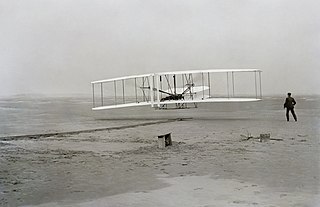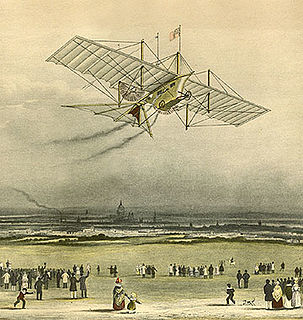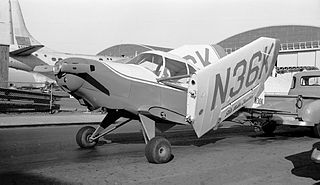
An aircraft is a vehicle that is able to fly by gaining support from the air. It counters the force of gravity by using either static lift or by using the dynamic lift of an airfoil, or in a few cases the downward thrust from jet engines. Common examples of aircraft include airplanes, helicopters, airships, gliders, paramotors and hot air balloons.

A fixed-wing aircraft is a heavier-than-air flying machine, such as an airplane, which is capable of flight using wings that generate lift caused by the aircraft's forward airspeed and the shape of the wings. Fixed-wing aircraft are distinct from rotary-wing aircraft, and ornithopters. The wings of a fixed-wing aircraft are not necessarily rigid; kites, hang gliders, variable-sweep wing aircraft and airplanes that use wing morphing are all examples of fixed-wing aircraft.

Propulsion is the action or process of pushing or pulling to drive an object forward. The term is derived from two Latin words: pro, meaning before or forward; and pellere, meaning to drive. A propulsion system consists of a source of mechanical power, and a propulsor.

A model aircraft is a small unmanned aircraft or, in the case of a scale model, a replica of an existing or imaginary aircraft. Model aircraft are divided into two basic groups: flying and non-flying. Non-flying models are also termed static, display, or shelf models.

The history of aviation extends for more than two thousand years, from the earliest forms of aviation such as kites and attempts at tower jumping to supersonic and hypersonic flight by powered, heavier-than-air jets.
This is a list of aviation-related events from 1933:
A motor glider is a fixed-wing aircraft that can be flown with or without engine power. The FAI Gliding Commission Sporting Code definition is: a fixed-wing aerodyne equipped with a means of propulsion (MoP), capable of sustained soaring flight without thrust from the means of propulsion. In the US, a powered glider may be certificated for up to two occupants, up to 850 kg maximum weight, and with a maximum ratio of weight to wing span squared of 3 kg/m2. Similar requirements exist in European JAA/EASA regulations, at a maximum weight of 750 kg.

In an aircraft with a pusher configuration, the propeller(s) are mounted behind their respective engine(s). According to British aviation author Bill Gunston, a "pusher propeller" is one mounted behind the engine, so that the drive shaft is in compression.
A variable-pitch propeller or controllable-pitch propeller (CPP) is a type of propeller with blades that can be rotated around their long axis to change the blade pitch. Reversible propellers—those where the pitch can be set to negative values—can also create reverse thrust for braking or going backwards without the need to change the direction of shaft revolution.

An airplane or aeroplane is a powered, fixed-wing aircraft that is propelled forward by thrust from a jet engine, propeller or rocket engine. Airplanes come in a variety of sizes, shapes, and wing configurations. The broad spectrum of uses for airplanes includes recreation, transportation of goods and people, military, and research. Worldwide, commercial aviation transports more than four billion passengers annually on airliners and transports more than 200 billion tonne-kilometers of cargo annually, which is less than 1% of the world's cargo movement. Most airplanes are flown by a pilot on board the aircraft, but some are designed to be remotely or computer-controlled such as drones.

A steam aircraft is an aircraft propelled by a steam engine. Steam aircraft were unusual devices because of the difficulty in producing a powerplant with a high enough power-to-weight ratio to be practical. They are distinct from airships that use steam as their lifting gas, which are known as thermal airships.

A radio-controlled aircraft is a small flying machine that is controlled remotely by an operator on the ground using a hand-held radio transmitter. The transmitter communicates with a receiver within the craft that sends signals to servomechanisms (servos) which move the control surfaces based on the position of joysticks on the transmitter. The control surfaces, in turn, affect the orientation of the plane.

A constant-speed propeller is a variable-pitch aircraft propeller that automatically changes its blade pitch in order to maintain a chosen rotational speed. The power delivered is proportional to the arithmetic product of rotational speed and torque, and the propeller operation places emphasis on torque. The operation better suits modern engines, particularly supercharged and gas turbine types.

The American Champion 8KCAB Decathlon and Super Decathlon are two-seat fixed conventional gear light airplanes designed for flight training and personal use and capable of sustaining aerobatic stresses between +6g and −5g. The Decathlon entered production in the United States in 1970 as a more powerful and stronger complement to the American Champion Citabria line of aircraft.

An electric aircraft is an aircraft powered by electric motors. Electricity may be supplied by a variety of methods including batteries, ground power cables, solar cells, ultracapacitors, fuel cells and power beaming. Small, electrically powered model aircraft have been flown since the 1970s, with one unconfirmed report as early as 1957. They have since developed into small unmanned aerial vehicles (UAV) or drones, which in the twenty-first century have become widely used for many purposes.

The Doble steam car was an American steam car maker from 1909 to 1931. Its latter models of steam car, with fast-firing boiler and electric start, were considered the pinnacle of steam car development. The term "Doble steam car" comprises any of several makes of steam-powered automobile in the early 20th century, including Doble Detroit, Doble Steam Car, and Doble Automobile, severally called a "Doble" because of their founding by Abner Doble.

In aeronautics, a propeller, also called an airscrew, converts rotary motion from an engine or other power source into a swirling slipstream which pushes the propeller forwards or backwards. It comprises a rotating power-driven hub, to which are attached several radial airfoil-section blades such that the whole assembly rotates about a longitudinal axis. The blade pitch may be fixed, manually variable to a few set positions, or of the automatically variable "constant-speed" type.

The Stits-Besler Executive is a three place homebuilt aircraft designed by Ray Stits, as the Stits SA-4A Executive.

On 13 July 2011, Noar Linhas Aéreas Flight 4896, a Let L-410 Turbolet passenger aircraft on a domestic service from Recife to Mossoró, Brazil, crashed shortly after take-off in the Boa Viagem neighbourhood of Recife, after suffering an engine failure. All 16 people on board were killed.

On October 30, 2014, a Beechcraft King Air B200 twin turboprop crashed into a building hosting a FlightSafety International (FSI) training center shortly after taking off from Wichita Mid-Continent Airport in Wichita, Kansas. The pilot, the only person on board, was killed along with three people in the building; six more people in the building were injured.
















